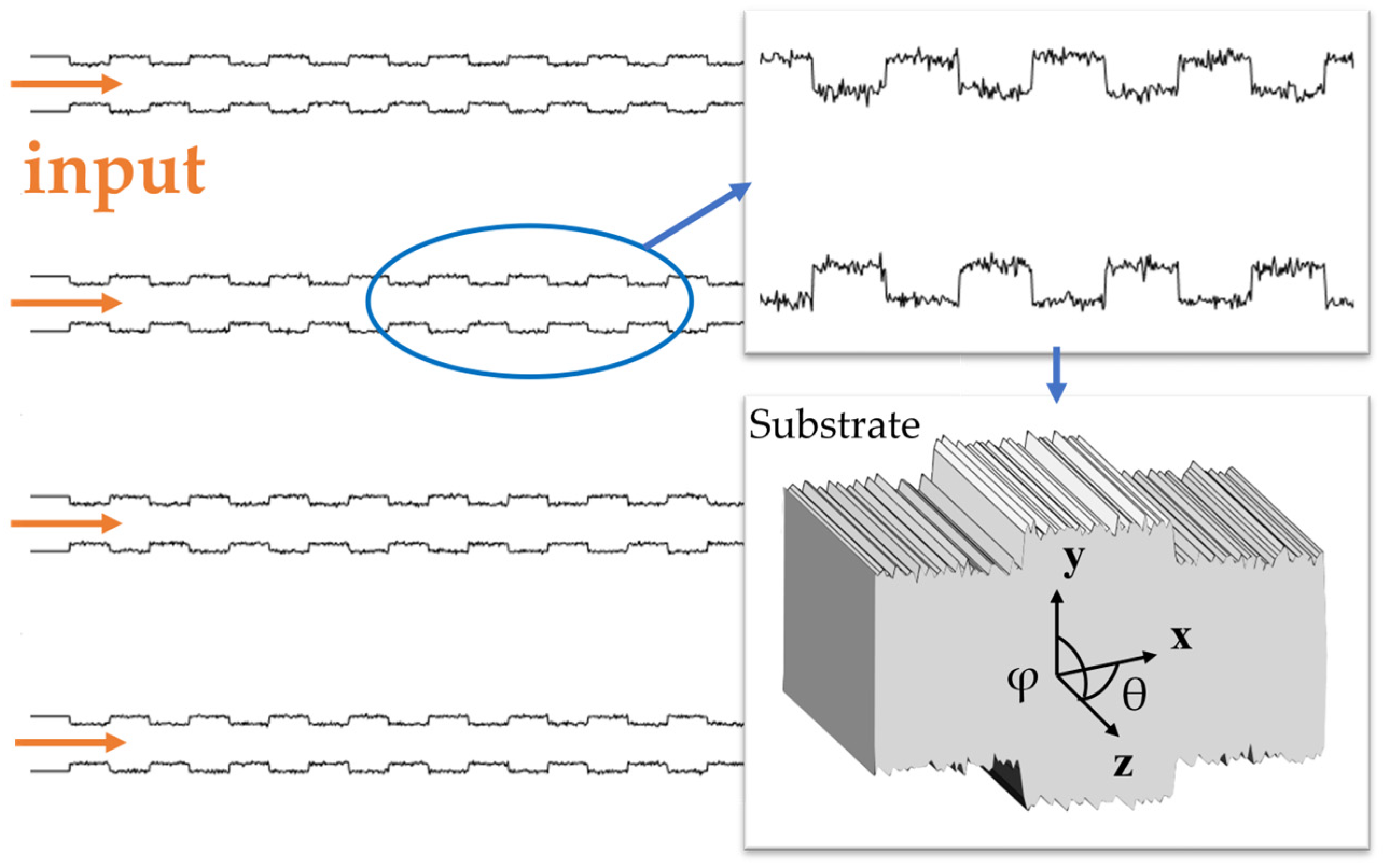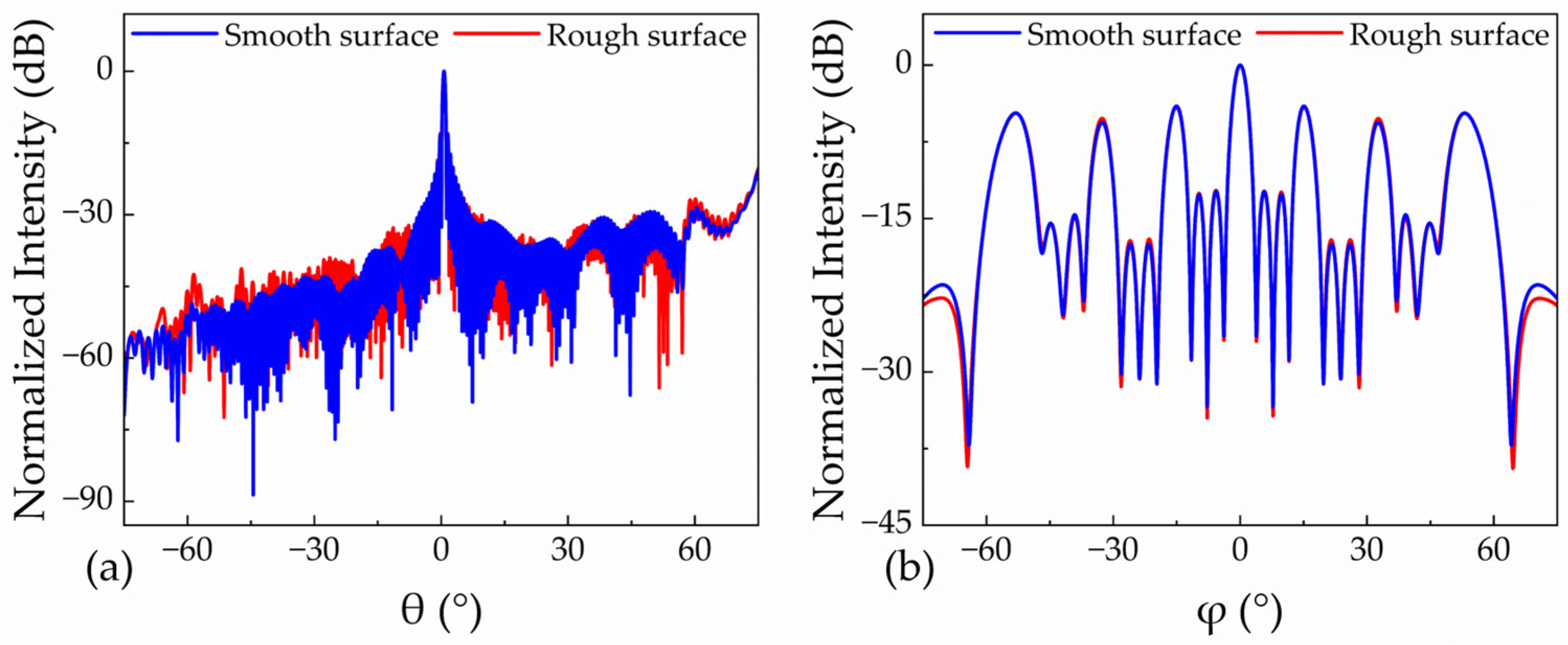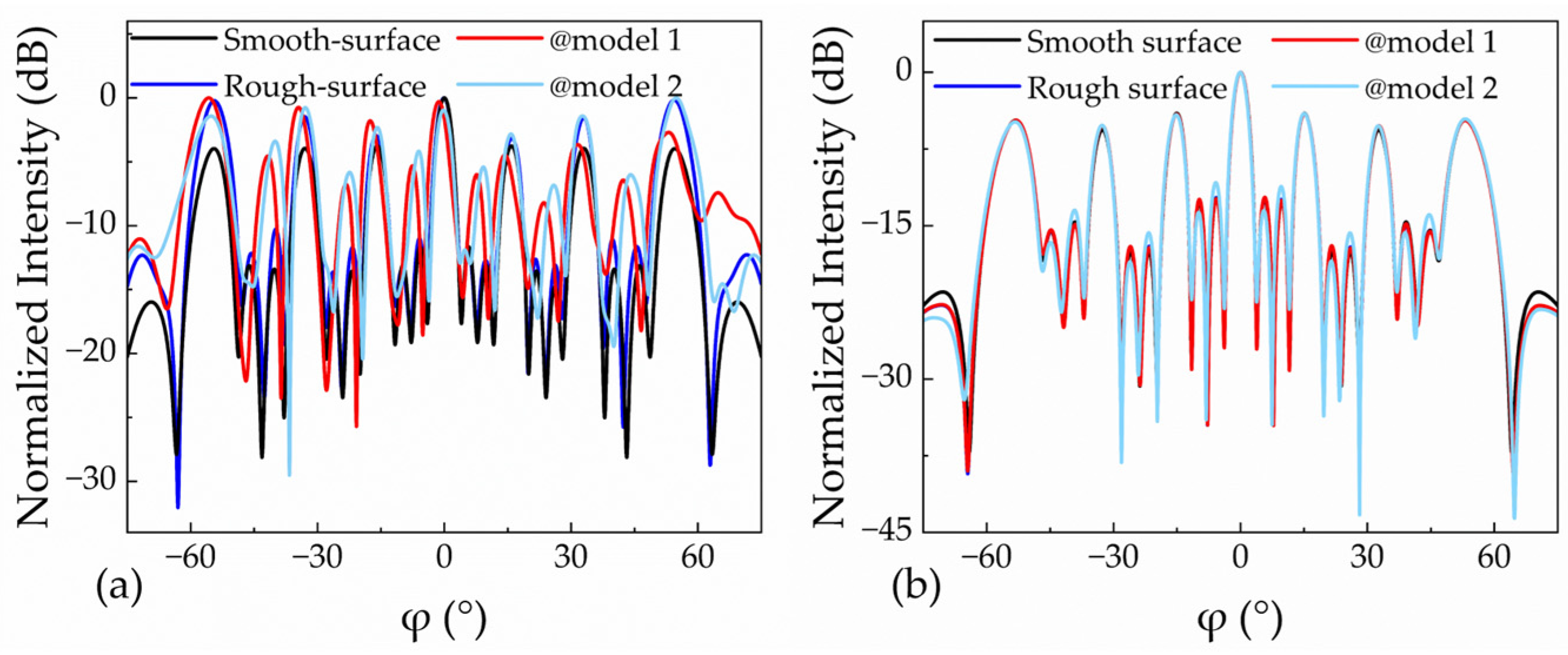Analysis of the Influence of Fabrication Errors on the Far-Field Performance of Si and Si3N4 Antennas
Abstract
:1. Introduction
2. Simulation and Analysis
3. Discussion
4. Conclusions
Author Contributions
Funding
Institutional Review Board Statement
Informed Consent Statement
Data Availability Statement
Conflicts of Interest
References
- Poulton, C.V.; Yaacobi, A.; Cole, D.B.; Byrd, M.J.; Raval, M.; Vermeulen, D.; Watts, M.R. Coherent Solid-State LIDAR with Silicon Photonic Optical Phased Arrays. Opt. Lett. 2017, 42, 4091. [Google Scholar] [CrossRef]
- Martin, A.; Verheyen, P.; De Heyn, P.; Absil, P.; Feneyrou, P.; Bourderionnet, J.; Dodane, D.; Leviandier, L.; Dolfi, D.; Naughton, A.; et al. Photonic Integrated Circuit-Based FMCW Coherent LiDAR. J. Light. Technol. 2018, 36, 4640–4645. [Google Scholar] [CrossRef]
- Li, C.; Cao, X.; Wu, K.; Li, X.; Chen, J. Lens-Based Integrated 2D Beam-Steering Device with Defocusing Approach and Broadband Pulse Operation for Lidar Application. Opt. Express 2019, 27, 32970. [Google Scholar] [CrossRef] [PubMed]
- Cao, X.; Qiu, G.; Wu, K.; Li, C.; Chen, J. Lidar System Based on Lens Assisted Integrated Beam Steering. Opt. Lett. 2020, 45, 5816. [Google Scholar] [CrossRef]
- Hsu, C.-P.; Li, B.; Solano-Rivas, B.; Gohil, A.R.; Chan, P.H.; Moore, A.D.; Donzella, V. A Review and Perspective on Optical Phased Array for Automotive LiDAR. IEEE J. Sel. Top. Quantum Electron. 2021, 27, 8300416. [Google Scholar] [CrossRef]
- Yu, L.; Ma, P.; Luo, G.; Cui, L.; Zhou, X.; Wang, P.; Zhang, Y.; Pan, J. Adoption of Large Aperture Chirped Grating Antennas in Optical Phase Array for Long Distance Ranging. Opt. Express 2022, 30, 28112–28120. [Google Scholar] [CrossRef]
- Poulton, C.V. Integrated LIDAR with Optical Phased Arrays in Silicon Photonics; Massachusetts Institute of Technology: Cambridge, MA, USA, 2016. [Google Scholar]
- Ashtiani, F.; Aflatouni, F. N × N Optical Phased Array with 2N Phase Shifters. Opt. Express 2019, 27, 27183. [Google Scholar] [CrossRef]
- Kim, J.-Y.; Yoon, J.; Kim, J.; Kwon, N.-H.; Rhee, H.-W.; Baek, M.; Lee, Y.; Park, H.-H.; Yoon, H. Demonstration of Beam Steering Using a Passive Silica Optical Phased Array with Wavelength Tuning. Opt. Lett. 2022, 47, 4857. [Google Scholar] [CrossRef] [PubMed]
- Sayyah, K.; Sarkissian, R.; Patterson, P.; Huang, B.; Efimov, O.; Kim, D.; Elliott, K.; Yang, L.; Hammon, D. Fully Integrated FMCW LiDAR Optical Engine on a Single Silicon Chip. J. Light. Technol. 2022, 40, 2763–2772. [Google Scholar] [CrossRef]
- Yu, L.; Wang, P.; Ma, P.; Cui, L.; Wang, Z.; Yang, Y.; Zhang, Y.; Pan, J. Two-Dimensional Beam Scanning of Passive Optical Phased Array Based on Silicon Nitride Delay Line. J. Light. Technol. 2023, 41, 2756–2764. [Google Scholar] [CrossRef]
- Zhang, D.; Zhang, F.; Pan, S. Grating-Lobe-Suppressed Optical Phased Array with Optimized Element Distribution. Opt. Commun. 2018, 419, 47–52. [Google Scholar] [CrossRef]
- Clevenson, H.A.; Spector, S.J.; Benney, L.; Moebius, M.G.; Brown, J.; Hare, A.; Huang, A.; Mlynarczyk, J.; Poulton, C.V.; Hosseini, E.; et al. Incoherent Light Imaging Using an Optical Phased Array. Appl. Phys. Lett. 2020, 116, 031105. [Google Scholar] [CrossRef]
- Guo, Y.; Guo, Y.; Li, C.; Zhang, H.; Zhou, X.; Zhang, L. Integrated Optical Phased Arrays for Beam Forming and Steering. Appl. Sci. 2021, 11, 4017. [Google Scholar] [CrossRef]
- Sacher, W.D.; Chen, F.-D.; Moradi-Chameh, H.; Liu, X.; Felts Almog, I.; Lordello, T.; Chang, M.; Naderian, A.; Fowler, T.M.; Segev, E.; et al. Optical Phased Array Neural Probes for Beam-Steering in Brain Tissue. Opt. Lett. 2022, 47, 1073. [Google Scholar] [CrossRef]
- Poulton, C.V.; Byrd, M.J.; Russo, P.; Moss, B.; Shatrovoy, O.; Khandaker, M.; Watts, M.R. Coherent LiDAR With an 8,192-Element Optical Phased Array and Driving Laser. IEEE J. Sel. Top. Quantum Electron. 2022, 28, 6100508. [Google Scholar] [CrossRef]
- Komljenovic, T.; Helkey, R.; Coldren, L.; Bowers, J.E. Sparse Aperiodic Arrays for Optical Beam Forming and LIDAR. Opt. Express 2017, 25, 2511. [Google Scholar] [CrossRef] [PubMed]
- Li, Y.; Chen, B.; Na, Q.; Xie, Q.; Tao, M.; Zhang, L.; Zhi, Z.; Li, Y.; Liu, X.; Luo, X.; et al. Wide-Steering-Angle High-Resolution Optical Phased Array. Photonics Res. 2021, 9, 2511. [Google Scholar] [CrossRef]
- Cui, L.; Wang, P.; Zhao, Q.; Ma, P.; Wang, Z.; Yu, L.; Yang, Y.; Zhang, Y.; Pan, J. Two-Dimensional Scanning of Silicon-Based Focal Plane Array with Field-of-View Splicing Technology. Opt. Express 2023, 31, 1464. [Google Scholar] [CrossRef]
- Yu, L.; Cui, L.; Wang, P.; Luo, G.; Ma, P.; Wang, Z.; Yang, Y.; Zhang, Y.; Pan, J. All-Solid-State Beam Scanning Based on the Ultra-Large-Scale Micro-Ring Optical Switch Array. In Proceedings of the 2023 Opto-Electronics and Communications Conference (OECC), Shanghai, China, 2–6 July 2023; IEEE: Piscataway, NJ, USA, 2023; pp. 1–4. [Google Scholar]
- Lambert, J.; Carballo, A.; Cano, A.M.; Narksri, P.; Wong, D.; Takeuchi, E.; Takeda, K. Performance Analysis of 10 Models of 3D LiDARs for Automated Driving. IEEE Access 2020, 8, 131699–131722. [Google Scholar] [CrossRef]
- Zeng, Y.S.; Qu, S.W.; Wu, J.W. Polarization-Division and Spatial-Division Shared-Aperture Nanopatch Antenna Arrays for Wide-Angle Optical Beam Scanning. Opt. Express 2020, 28, 12805. [Google Scholar] [CrossRef]
- Yan, X.; Chen, J.; Dai, D.; Shi, Y. Polarization Multiplexing Silicon-Photonic Optical Phased Array for 2D Wide-Angle Optical Beam Steering. IEEE Photonics J. 2021, 13, 6600506. [Google Scholar] [CrossRef]
- Zhao, S.; Lian, D.; Chen, J.; Dai, D.; Shi, Y. Polarization Multiplexing Silicon Photonic Optical Phased Array with a Wide Scanning Range. Opt. Lett. 2023, 48, 6092. [Google Scholar] [CrossRef]
- Miller, S.A.; Chang, Y.-C.; Phare, C.T.; Shin, M.C.; Zadka, M.; Roberts, S.P.; Stern, B.; Ji, X.; Mohanty, A.; Jimenez Gordillo, O.A.; et al. Large-Scale Optical Phased Array Using a Low-Power Multi-Pass Silicon Photonic Platform. Optica 2020, 7, 3. [Google Scholar] [CrossRef]
- Sun, C.; Yang, L.; Li, B.; Shi, W.; Wang, H.; Chen, Z.; Nie, X.; Deng, S.; Ding, N.; Zhang, A. Parallel Emitted Silicon Nitride Nanophotonic Phased Arrays for Two-Dimensional Beam Steering. Opt. Lett. 2021, 46, 5699. [Google Scholar] [CrossRef]
- Raval, M.; Poulton, C.V.; Watts, M.R. Unidirectional Waveguide Grating Antennas with Uniform Emission for Optical Phased Arrays. Opt. Lett. 2017, 42, 2563. [Google Scholar] [CrossRef] [PubMed]
- Wang, Z.; Yu, L.; Yang, Y.; Ma, P.; Cui, L.; Luo, S.; Ji, Z.; Song, Z.; Su, Y.; Pan, J.; et al. Wide Field of View Optical Phased Array with a High-Directionality Antenna. Opt. Express 2023, 31, 21192–21199. [Google Scholar] [CrossRef]
- Shang, K.; Qin, C.; Zhang, Y.; Liu, G.; Xiao, X.; Feng, S.; Yoo, S.J.B. Uniform emission, constant wavevector silicon grating surface emitter for beam steering with ultra-sharp instantaneous field-of-view. Opt. Express 2017, 25, 19655. [Google Scholar] [CrossRef] [PubMed]
- Wang, Q.; Wang, S.; Jia, L.; Cai, Y.; Yue, W.; Yu, M. Silicon Nitride Assisted 1 × 64 Optical Phased Array Based on a SOI Platform. Opt. Express 2021, 29, 10509. [Google Scholar] [CrossRef]
- Luo, G.; Yu, L.; Ma, P.; Wang, R.; Cui, L.; Wang, Z.; Yu, H.; Zhou, X.; Wang, P.; Zhang, Y.; et al. A Large-Scale Passive Optical Phase Array With 1024 Channels. IEEE Photonics Technol. Lett. 2023, 35, 927–930. [Google Scholar] [CrossRef]
- Xie, W.; Huang, J.; Komljenovic, T.; Coldren, L.A.; Bowers, J.E. Diffraction Limited Centimeter Scale Radiator: Metasurface Grating Antenna for Phased Array LiDAR. arXiv 2018, arXiv:1810.00109. [Google Scholar]
- Wang, P.; Luo, G.; Xu, Y.; Li, Y.; Su, Y.; Ma, J.; Wang, R.; Yang, Z.; Zhou, X.; Zhang, Y.; et al. Design and Fabrication of a SiN-Si Dual-Layer Optical Phased Array Chip. Photonics Res. 2020, 8, 912. [Google Scholar] [CrossRef]
- Liu, Y.; Hu, H. Silicon Optical Phased Array with a 180-Degree Field of View for 2D Optical Beam Steering. Optica 2022, 9, 903. [Google Scholar] [CrossRef]
- Poulton, C.V.; Byrd, M.J.; Russo, P.; Timurdogan, E.; Khandaker, M.; Vermeulen, D.; Watts, M.R. Long-Range LiDAR and Free-Space Data Communication With High-Performance Optical Phased Arrays. IEEE J. Sel. Top. Quantum Electron. 2019, 25, 7700108. [Google Scholar] [CrossRef]
- Im, C.-S.; Bhandari, B.; Lee, K.-P.; Kim, S.-M.; Oh, M.-C.; Lee, S.-S. Silicon Nitride Optical Phased Array Based on a Grating Antenna Enabling Wavelength-Tuned Beam Steering. Opt. Express 2020, 28, 3270. [Google Scholar] [CrossRef]
- Munoz, P.; Pastor, D.; Bru, L.A.; Cabanes, G.M.; Benitez, J.; Goodwill, D.; Bernier, E. Scalable Switched Slab Coupler Based Optical Phased Array on Silicon Nitride. IEEE J. Sel. Top. Quantum Electron. 2022, 28, 8300416. [Google Scholar] [CrossRef]
- Jaberansary, E.; Masaud, T.M.B.; Milosevic, M.M.; Nedeljkovic, M.; Mashanovich, G.Z.; Chong, H.M.H. Scattering Loss Estimation Using 2-D Fourier Analysis and Modeling of Sidewall Roughness on Optical Waveguides. IEEE Photonics J. 2013, 5, 6601010. [Google Scholar] [CrossRef]
- Bakirtzis, S.; Zhang, X.; Sarris, C.D. Stochastic Modeling of Wave Propagation in Waveguides With Rough Surface Walls. IEEE Trans. Microw. Theory Tech. 2021, 69, 500–508. [Google Scholar] [CrossRef]





| Materials | φ Direction | θ Direction | ||||||
|---|---|---|---|---|---|---|---|---|
| SLL | η | SLL | η | |||||
| Smooth | Rough | Smooth | Rough | Smooth | Rough | Smooth | Rough | |
| Si | −10.97 dB | −9.74 dB | 15.02% | 9.38% (−5.64%) | −12.81 dB | −12.00 dB | 70.37% | 66.76% (−3.61%) |
| −10.88 dB | 9.14% (−5.88%) | −12.28 dB | 66.95% (−3.42%) | |||||
| −9.68 dB | 9.19% (−5.83%) | −12.63 dB | 66.19% (−4.18%) | |||||
| Average: 9.24% (−5.78%) | Average: 66.63% (−3.74%) | |||||||
| Si3N4 | −12.34 dB | −12.26 dB | 18.55% | 18.26% (−0.29%) | −13.00 dB | −13.01 dB | 69.24% | 68.27% (−0.97%) |
| −12.29 dB | 18.10% (−0.45%) | −12.98 dB | 68.69% (−0.55%) | |||||
| −12.23 dB | 18.12% (−0.43%) | −13.00 dB | 68.64% (−0.60%) | |||||
| Average: 18.16% (−0.39%) | Average: 68.53% (−0.71%) | |||||||
| Effective Length (μm) | φ Direction | θ Direction | |||||||
|---|---|---|---|---|---|---|---|---|---|
| SLL | η | SLL | η | ||||||
| Smooth | Rough | Smooth | Rough | Smooth | Rough | Smooth | Rough | ||
| Si | 50 | −10.73 dB | −10.16 dB | 12.10% | 8.05% (−4.05%) | −12.87 dB | −12.56 dB | 70.15% | 67.23% (−2.92%) |
| −11.03 dB | 8.26% (−3.84%) | −12.65 dB | 67.78% (−2.37%) | ||||||
| −9.63 dB | 8.20% (−3.92%) | −12.05 dB | 67.41% (−2.74%) | ||||||
| Average: 8.17% (−3.93%) | Average: 67.47% (−2.68%) | ||||||||
| 70 | −10.83 dB | −10.85 dB | 13.45% | 8.98% (−4.46%) | −12.78 dB | −12.33 dB | 69.80% | 67.36% (−2.45%) | |
| −9.96 dB | 8.48% (−4.97%) | −12.25 dB | 67.43% (−2.37%) | ||||||
| −11.02 dB | 8.60% (−4.85%) | −12.45 dB | 65.68% (−4.12%) | ||||||
| Average: 8.67% (−4.76%) | Average: 66.82% (−2.98%) | ||||||||
| 100 | −10.97 dB | −9.74 dB | 15.02% | 9.38% (−5.64%) | −12.81 dB | −12.00 dB | 70.37% | 66.76% (−3.61%) | |
| −10.88 dB | 9.14% (−5.88%) | −12.28 dB | 66.95% (−3.42%) | ||||||
| −9.68 dB | 9.19% (−5.83%) | −12.63 dB | 66.19% (−4.18%) | ||||||
| Average: 9.24% (−5.78%) | Average: 66.63% (−3.74%) | ||||||||
| 130 | −11.15 dB | −10.51 dB | 14.89% | 9.73% (−5.16%) | −12.72 dB | −11.09 dB | 70.50% | 66.05% (−4.45%) | |
| −8.86 dB | 9.24% (−5.65%) | −12.25 dB | 67.01% (−3.49%) | ||||||
| −10.86 dB | 9.77% (−5.12%) | −11.99 dB | 64.58% (−5.92%) | ||||||
| Average: 9.58% (−5.31%) | Average: 65.88% (−4.62%) | ||||||||
Disclaimer/Publisher’s Note: The statements, opinions and data contained in all publications are solely those of the individual author(s) and contributor(s) and not of MDPI and/or the editor(s). MDPI and/or the editor(s) disclaim responsibility for any injury to people or property resulting from any ideas, methods, instructions or products referred to in the content. |
© 2024 by the authors. Licensee MDPI, Basel, Switzerland. This article is an open access article distributed under the terms and conditions of the Creative Commons Attribution (CC BY) license (https://creativecommons.org/licenses/by/4.0/).
Share and Cite
Xin, Y.; Liao, W.; Yu, L.; Ma, P.; Wang, Z.; Yang, Y.; Chen, L.; Wang, P.; Zhang, Y.; Pan, J. Analysis of the Influence of Fabrication Errors on the Far-Field Performance of Si and Si3N4 Antennas. Photonics 2024, 11, 81. https://doi.org/10.3390/photonics11010081
Xin Y, Liao W, Yu L, Ma P, Wang Z, Yang Y, Chen L, Wang P, Zhang Y, Pan J. Analysis of the Influence of Fabrication Errors on the Far-Field Performance of Si and Si3N4 Antennas. Photonics. 2024; 11(1):81. https://doi.org/10.3390/photonics11010081
Chicago/Turabian StyleXin, Yifan, Wenyuan Liao, Lei Yu, Pengfei Ma, Zheng Wang, Yibo Yang, Licheng Chen, Pengfei Wang, Yejin Zhang, and Jiaoqing Pan. 2024. "Analysis of the Influence of Fabrication Errors on the Far-Field Performance of Si and Si3N4 Antennas" Photonics 11, no. 1: 81. https://doi.org/10.3390/photonics11010081





